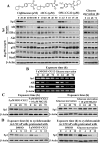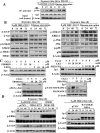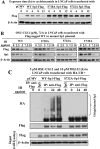Thiazolidinediones mimic glucose starvation in facilitating Sp1 degradation through the up-regulation of beta-transducin repeat-containing protein
- PMID: 19372209
- PMCID: PMC2701453
- DOI: 10.1124/mol.109.055376
Thiazolidinediones mimic glucose starvation in facilitating Sp1 degradation through the up-regulation of beta-transducin repeat-containing protein
Abstract
This study investigated the mechanism by which the transcription factor Sp1 is degraded in prostate cancer cells. We recently developed a thiazolidinedione derivative, (Z)-5-(4-hydroxy-3-trifluoromethylbenzylidene)-3-(1-methylcyclohexyl)-thiazolidine-2,4-dione (OSU-CG12), that induces Sp1 degradation in a manner paralleling that of glucose starvation. Based on our finding that thiazolidinediones suppress beta-catenin and cyclin D1 by up-regulating the E3 ligase SCF(beta-TrCP), we hypothesized that beta-transducin repeat-containing protein (beta-TrCP) targets Sp1 for proteasomal degradation in response to glucose starvation or OSU-CG12. Here we show that either treatment of LNCaP cells increased specific binding of Sp1 with beta-TrCP. This direct binding was confirmed by in vitro pull-down analysis with bacterially expressed beta-TrCP. Although ectopic expression of beta-TrCP enhanced the ability of OSU-CG12 to facilitate Sp1 degradation, suppression of endogenous beta-TrCP function by a dominant-negative mutant or small interfering RNA-mediated knockdown blocked OSU-CG12-facilitated Sp1 ubiquitination and/or degradation. Sp1 contains a C-terminal conventional DSG destruction box ((727)DSGAGS(732)) that mediates beta-TrCP recognition and encompasses a glycogen synthase kinase 3beta (GSK3beta) phosphorylation motif (SXXXS). Pharmacological and molecular genetic approaches and mutational analyses indicate that extracellular signal-regulated kinase-mediated phosphorylation of Thr739 and GSK3beta-mediated phosphorylation of Ser728 and Ser732 were critical for Sp1 degradation. The ability of OSU-CG12 to mimic glucose starvation to activate beta-TrCP-mediated Sp1 degradation has translational potential to foster novel strategies for cancer therapy.
Figures








Similar articles
-
A novel mechanism by which thiazolidinediones facilitate the proteasomal degradation of cyclin D1 in cancer cells.J Biol Chem. 2008 Sep 26;283(39):26759-70. doi: 10.1074/jbc.M802160200. Epub 2008 Jul 23. J Biol Chem. 2008. PMID: 18650423 Free PMC article.
-
Thiazolidinediones modulate the expression of beta-catenin and other cell-cycle regulatory proteins by targeting the F-box proteins of Skp1-Cul1-F-box protein E3 ubiquitin ligase independently of peroxisome proliferator-activated receptor gamma.Mol Pharmacol. 2007 Sep;72(3):725-33. doi: 10.1124/mol.107.035287. Epub 2007 Jun 14. Mol Pharmacol. 2007. PMID: 17569795
-
Regulation of Transcription Factor SP1 by the β-Catenin Destruction Complex Modulates Wnt Response.Mol Cell Biol. 2018 Oct 29;38(22):e00188-18. doi: 10.1128/MCB.00188-18. Print 2018 Nov 15. Mol Cell Biol. 2018. PMID: 30181396 Free PMC article.
-
The characteristics and roles of β-TrCP1/2 in carcinogenesis.FEBS J. 2021 Jun;288(11):3351-3374. doi: 10.1111/febs.15585. Epub 2020 Oct 23. FEBS J. 2021. PMID: 33021036 Review.
-
Structural and functional characterization of Nrf2 degradation by glycogen synthase kinase 3/β-TrCP.Free Radic Biol Med. 2015 Nov;88(Pt B):147-157. doi: 10.1016/j.freeradbiomed.2015.04.029. Epub 2015 Apr 30. Free Radic Biol Med. 2015. PMID: 25937177 Review.
Cited by
-
Insulin-like growth factor-I receptor is suppressed through transcriptional repression and mRNA destabilization by a novel energy restriction-mimetic agent.Carcinogenesis. 2013 Dec;34(12):2694-705. doi: 10.1093/carcin/bgt251. Epub 2013 Jul 16. Carcinogenesis. 2013. Retraction in: Carcinogenesis. 2019 Apr 29;40(2):e14. doi: 10.1093/carcin/bgz055. PMID: 23864387 Free PMC article. Retracted.
-
Vanguard is a Glucose Deprivation-Responsive Long Non-Coding RNA Essential for Chromatin Remodeling-Reliant DNA Repair.Adv Sci (Weinh). 2022 Oct;9(30):e2201210. doi: 10.1002/advs.202201210. Epub 2022 Sep 1. Adv Sci (Weinh). 2022. PMID: 36047643 Free PMC article.
-
Interaction and Collaboration of SP1, HIF-1, and MYC in Regulating the Expression of Cancer-Related Genes to Further Enhance Anticancer Drug Development.Curr Issues Mol Biol. 2023 Nov 17;45(11):9262-9283. doi: 10.3390/cimb45110580. Curr Issues Mol Biol. 2023. PMID: 37998757 Free PMC article. Review.
-
SCFβ-TrCP ubiquitinates CHK1 in an AMPK-dependent manner in response to glucose deprivation.Mol Oncol. 2019 Feb;13(2):307-321. doi: 10.1002/1878-0261.12403. Epub 2018 Dec 3. Mol Oncol. 2019. PMID: 30428154 Free PMC article.
-
Role of post-translational modifications of Sp1 in cancer: state of the art.Front Cell Dev Biol. 2024 Aug 20;12:1412461. doi: 10.3389/fcell.2024.1412461. eCollection 2024. Front Cell Dev Biol. 2024. PMID: 39228402 Free PMC article. Review.
References
-
- Benasciutti E, Pagès G, Kenzior O, Folk W, Blasi F, and Crippa MP (2004) MAPK and JNK transduction pathways can phosphorylate Sp1 to activate the uPA minimal promoter element and endogenous gene transcription. Blood 104 256-262. - PubMed
-
- Bhatia N, Thiyagarajan S, Elcheva I, Saleem M, Dlugosz A, Mukhtar H, and Spiegelman VS (2006) Gli2 is targeted for ubiquitination and degradation by beta-TrCP ubiquitin ligase. J Biol Chem 281 19320-19326. - PubMed
-
- Bonello MR and Khachigian LM (2004) Fibroblast growth factor-2 represses platelet-derived growth factor receptor-α (PDGFR-α) transcription via ERK1/2-dependent Sp1 phosphorylation and an atypical cis-acting element in the proximal PDGFR-α promoter. J Biol Chem 279 2377-2382. - PubMed
-
- Chu S and Ferro TJ (2006) Identification of a hydrogen peroxide-induced PP1-JNK1-Sp1 signaling pathway for gene regulation. Am J Physiol Lung Cell Mol Physiol 291 L983-L992. - PubMed
Publication types
MeSH terms
Substances
Grants and funding
LinkOut - more resources
Full Text Sources
Other Literature Sources
Molecular Biology Databases
Research Materials
Miscellaneous

